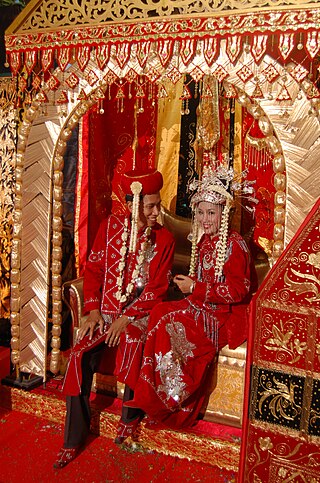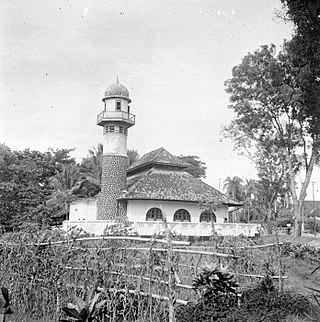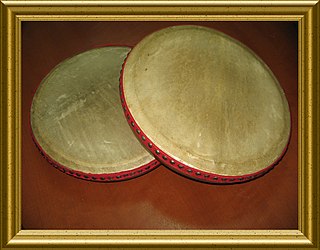
Betawi people, Batavi, or Batavians, are an Austronesian ethnic group native to the city of Jakarta and its immediate outskirts, as such often described as the inhabitants of the city. They are the descendants of the people who inhabited Batavia from the 17th century onwards.

Pasar Minggu is a district in the administrative city of South Jakarta, Indonesia. The area is known for its traditional Sunday market, famous for the fruit market. Historically, Pasar Minggu is a fruit cultivation area developed by the Dutch government during the colonial period. The central point of the cultivation area is the traditional market of Pasar Minggu, located in what is now the lower-division Pasar Minggu subdistrict. Teak forest could also be found in the Pasar Minggu district, notably around the Jati Padang subdistrict. Most of these areas have been converted into residential areas as Jakarta grows southward.
Jagakarsa is the southernmost district in the administrative city of South Jakarta, Indonesia. Jagakarsa is bounded by Ciliwung River to the east, Krukut River to the west, and Margasatwa-Sagu-Joe-T.B.Simatupang-Poltangan Road to the north, while the boundary marches with Depok city to the south.

Cilincing is a historic neighborhood and administrative district (kecamatan) on the coast of North Jakarta Administrative City, Indonesia. It is sandwiched between the Port of Tanjung Priok to the west and River Titram to the east. Cilincing has been for some decades one of the districts of North Jakarta which in turn encompasses as far as Marunda and some non-coastal hinterland.

Betawi, also known as Betawi Malay, Jakartan Malay, or Batavian Malay, is the spoken language of the Betawi people in Jakarta, Indonesia. It is the native language of perhaps 5 million people; a precise number is difficult to determine due to the vague use of the name.
The Batin are a sub-group of Malay people that inhabits the interior parts of Jambi province

Soekarno M. Noor was an Indonesian actor and film producer. He acted in 118 films and dramas.

Ondel-ondel is a large puppet figure featured in the Betawi folk performance in Jakarta, Indonesia. As an icon of Jakarta, ondel-ondel is often utilized as a pair for livening up festivals or welcoming guests of honor. It is one of a few Indonesian folk performances that has survived modernization and is still being regularly performed.

Benteng people are a Chinese Indonesian community of 'Peranakan' or mixed descent, native to the historic Tangerang area in the modern-day Indonesian provinces of Jakarta, Banten and West Java.
Nawi Ismail was an Indonesian film director and actor. He often worked with Dicky Zulkarnaen and Benyamin Sueb.

Masjid Jami' Al-Makmur Cikini is located on Jalan Raden Saleh Raya in Cikini, Central Jakarta, and is one of the oldest mosques in the locality. It was formerly known as Tjikini Mosque.
Perguruan Silat Mustika Kwitang, or simply called Kwitang silat, is a Betawinese pencak silat style. It was originally developed in the Kwitang village, which is now part of the Senen subdistrict in Central Jakarta, Indonesia. This style is a hybrid martial arts, developed by combining the local silat with the Chinese-influenced kuntao. The Mustika Kwitang Silat School was founded in 1945 by H. Muhammad Djaelani, who previously studied the martial arts from his own family.
In Indonesian law, the term "city" is generally defined as the second-level administrative subdivision of the Republic of Indonesia, an equivalent to regency. The difference between a city and a regency is that a city has non-agricultural economic activities and a dense urban population, while a regency comprises predominantly rural areas and is larger in area than a city. However, Indonesia historically had several classifications of cities.

A lancang is a type of sailing ship from Maritime Southeast Asia. It is used as warship, lighter, and as royal ship, particularly used by the people of Malay Peninsula, Sumatran east coast, but can also be found in the coast of Kalimantan.

The Regent of Thousand Islands, officially the Administrative Regent of Thousand Islands, is the highest office in the regency of Thousand Islands. Unlike regents in other regencies in Indonesia, the regent is appointed directly by the governor. The regency has no regional parliament, thus making the regent responsible to the governor.

Kompang is a traditional Balinese and Javanese musical instrument part of gamelan in the percussion family originated from the Indonesian region of Ponorogo in East Java. Kompang has existed in Indonesia since at least the 8th century and has spread to various regions of Indonesia as well as the Southeast Asia in general, such as Singapore, Malaysia, Brunei and Thailand, which later became known as Kompang Jawa.

Yapong dance is a Betawi dance originating in Jakarta, Indonesia. This dance depicts the association of young people created by the artist Bagong Kussudiardja. The Yapong dance was performed for the first time to enliven Jakarta's 450th anniversary event in 1977.
Rumah Panggung is one type of traditional Betawi house whose floor is raised from the ground using wooden poles. This house is different from a Rumah Darat that sticks to the ground. Betawi houses on stilts are built in coastal areas with the aim of dealing with floods or tides. Meanwhile, stilt houses located on the banks of rivers such as in Bekasi are not only built to avoid flooding, but also for safety from wild animals.















